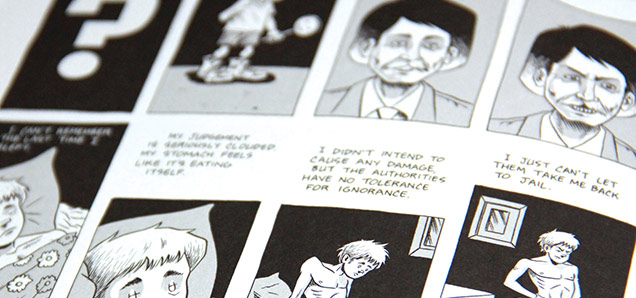Wizzywig: Portrait of a Serial Hacker
 CREDIT: ED PISKOR
CREDIT: ED PISKORPiskor's art style is one to be admired, easily depicting the emotion of the characters through his illustration, making the storytelling both immersive and believable.
This week’s comic book, Wizzywig: Portrait of a Serial Hacker by Ed Piskor, was recommended by Brahm Wiseman at Heroes Comics.
Wizzywig is a play on the acronym, “What You See Is What You Get”, but Wizzywig is anything but that.
Although Wizzywig is Ed Piskor’s first real solo release, he proves that he’s a gifted writer as well as a gifted artist. If you are a comic book regular, you may have encountered Piskor’s art style in Harvey Pekar’s American Splendor, an autobiographical comic book series that helped pave the wave for mainstream comics.
If you haven’t run into Piskor yet, then you are in for a treat with his gritty black and white style. He uses deep contrast and stylized backgrounds to capture the characters on the rollercoaster ride of emotions found in Wizzywig. The episodic way in which Wizzywig is told gives you glimpses of the past and present, telling the tale of a man’s rise – or fall, depending on how you see it – to criminal fame.
Wizzywig centres on Kevin “Boingthump” Phenicle, a computer hacker. The book starts with a young Kevin in the 1970’s, where it becomes obvious that he’s not wellliked by the other kids. The second panel the reader even meets Kevin he’s being asked, “Why you at our bus stop, Kevin Cuntface?”
After his parents’ death at a young age his grandmother takes over his care. Because of his situation, he spends much of his time alone, keeping himself occupied in his many hobbies. Kevin’s a puzzle- solver at heart, but his passion takes a criminal turn rather quickly once he realizes how easy it is to get away with things.
The first glimpse of Kevin’s genius comes from a simple question he asks the bus driver about where to find the “special hole puncher” to make the star shapes on the bus transfers, telling the bus driver he wants it for an astronomy project at school. The reader quickly learns after a dumpster diving session for unused bus transfers that Kevin wasn’t asking for a school project. Kevin uses his hack the rest of the day to bypass the punch card system used by the buses to get free rides.
He’s able to quickly find the most genius, albeit illegal, solutions to everyone’s problems, including his own. From using fake quarters at the arcade, getting free pizza by conning an unsuspecting business owner, and making long distance calls by using his perfect pitch to mimic the necessary 2600 Hz tone into the receiver, Kevin starts relatively small. It’s obvious that his talent makes him feel special in a world where he feels otherwise unaccepted or unappreciated.
Winston is his only friend, who shares in many of his early passions, even pushing him to do more at times. Their first close call with the authorities plants a deep fear into Winston that stops him from pursuing the same path as Kevin, but it doesn’t ruin their friendship. Most of the story of Kevin’s present life comes from Winston’s radio show that he uses to help bring Kevin justice.
Kevin’s crimes get more serious when he receives his first new computer as a birthday gift from his grandmother. From there, it’s all downhill.
After graduating college, Kevin takes his skills to a new level, breaking more and more laws in the name of “doing what’s right” until it’s no longer about what’s right, but self-preservation. In a time when technology was terrifying to people, Kevin became the most hated man in America, fast. The public, as well as many top government officials, cannot begin to understand what “Boingthump” the hacker is really capable of.
Therein lies the real story behind this novel.
Wizzywig touches on the sensationalism and fear mongering that news outlets use to scare the general public into believing anything. Kevin eventually goes to prison and his time there takes a hard look at the corruption present in the legal and penal system in America and the media’s role in keeping these injustices quiet.
While the novel can be incredibly serious, sometimes even dark and raunchy, there are many side stories that help balance the overall tone of the book. Some panels even feature a young Steve Jobs and Steve Wozniak.
This book is a good read. It takes you on a journey that is unique in both its artistic style, and subject matter. You’re left with a deeper understanding of the hacking world and the people who exist inside it. Not everyone is a criminal, and not every criminal is a bad person. Desperate times in a social period where technology was evil can make anyone go a little crazy.
For this novel, or others like it, check out Heroes Comics downtown at 186 Dundas St.













